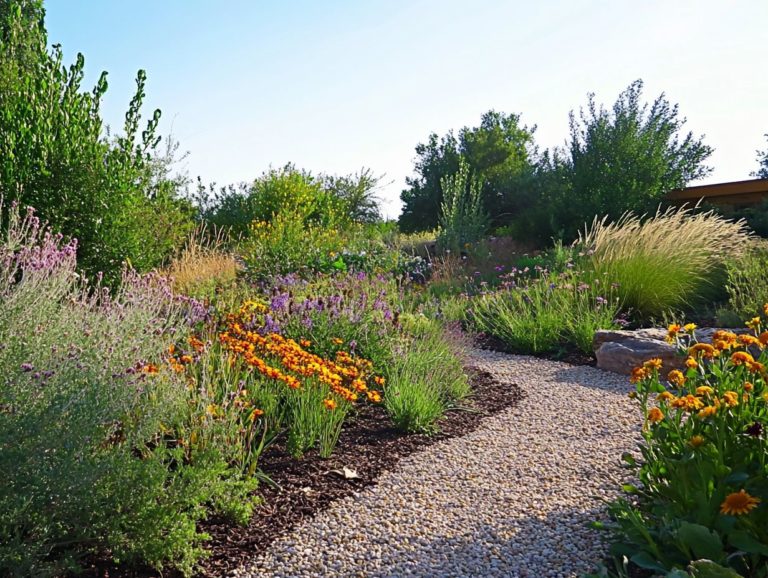How to Mulch for Drought-Resistant Plants?
Mulching is an essential gardening technique that can greatly improve the health and resilience of your plants, especially in areas prone to drought.
Understanding what mulch is and its benefits is the first step toward cultivating a thriving garden.
This guide will help you select the ideal type of mulch for your drought-resistant plants, prepare your garden, and apply mulch effectively.
You will also find valuable tips on maintaining your mulch and strategies for conserving water.
Discover how to keep your garden thriving, even in tough conditions! Your plants will thank you!
Contents
- Key Takeaways:
- Understanding Mulch and Its Benefits
- Choosing the Right Mulch for Drought-Resistant Plants
- Preparing Your Garden for Mulching
- Applying Mulch to Your Garden
- Techniques and Tips for Proper Mulching
- Maintaining Mulch for Drought-Resistant Plants
- Additional Tips for Water Conservation in Your Garden
- Frequently Asked Questions
- What is mulching and why does it help drought-tolerant plants?
- What types of mulch are best for drought-resistant plants?
- How thick should the mulch layer be for drought-resistant plants?
- When is the best time to mulch for drought-resistant plants?
- How often should mulch be replenished for drought-resistant plants?
- Can too much mulch be harmful for drought-resistant plants?
Key Takeaways:

- Choose the right type of mulch for your drought-resistant plants to retain moisture and regulate soil temperature.
- Clear and prepare the soil before applying mulch to ensure proper absorption and effectiveness.
- Mulch maintenance is crucial for the success of your drought-resistant plants. Regularly check and replenish mulch as needed.
Understanding Mulch and Its Benefits
Understanding mulch and its many benefits is essential for gardeners. It helps create a sustainable landscape that can thrive during droughts.
Sheet mulching, a valued practice in sustainable gardening methods, entails layering organic mulch materials to enrich soil health, conserve precious water, and suppress unruly weeds.
By utilizing various mulch types, including organic mulch and worm castings, you can enhance soil nutrients, protect native plants, and establish resilient, drought-tolerant ecosystems that require less maintenance.
What is Mulch and Why Is It Important?
Mulch is that magical layer of material you place on the soil’s surface. It serves multiple essential functions in gardening, such as enhancing soil health and promoting water conservation.
By adding mulch, you create a protective barrier that nurtures the ecosystem beneath it. Among the many options available, organic mulches like shredded bark, wood chips, straw, and leaf mold shine for their numerous benefits.
These natural materials enrich the soil with nutrients as they decompose, while also retaining moisture during dry spells, which means less frequent watering for you.
Organic mulch acts as a strong barrier against weeds. This significantly reduces their growth and competition for your precious resources.
This eco-friendly approach is vital for sustainable gardening practices, fostering healthier plants and promoting biodiversity in your garden.
Choosing the Right Mulch for Drought-Resistant Plants
Choosing the right mulch for your drought-resistant plants requires a nuanced understanding of your garden’s specific needs and the various types of mulch available. Additionally, knowing how to prepare soil for drought-resistant plants can profoundly influence the health and growth of your native plants.
Opting for organic mulch like wood chips or shredded leaves can enrich the soil’s nutrients and enhance moisture retention. This makes it an excellent choice for cultivating xeric gardens, which need very little water, as highlighted in the benefits of mulching in drought gardening.
Types of Mulch and Their Benefits
You’ll find various types of mulch, each offering unique benefits that can enhance your garden maintenance and improve overall soil health.
Take organic mulch made from compost, for example. It not only enriches the soil with essential nutrients but also helps keep pesky weeds at bay.
Consider straw as another excellent option, especially in vegetable gardens. It regulates soil temperature and promotes moisture retention, ensuring your roots stay hydrated, even during hot summer days.
Wood chips, often sourced from tree trimmings, are another versatile choice. They break down slowly, providing long-lasting benefits while suppressing weeds and improving soil structure over time.
If you re designing flower beds, think about incorporating a mix of these materials. This not only creates a visually pleasing layer but also protects your plants and enriches the planting environment, making it a haven for healthy growth.
Preparing Your Garden for Mulching

Preparing your garden for mulching is an essential step. Start by clearing the soil of debris and weeds. Then, apply soil amendments like cardboard and organic matter to create a rich topsoil layer that nurtures plant growth.
This meticulous preparation promotes keeping water in the soil and helps prevent root decay, ensuring a thriving environment for your drought-tolerant plants.
Clearing and Preparing the Soil
Clearing and preparing the soil is crucial for making sure your mulch works best. This process removes debris and creates a nurturing environment for your plants, while also preventing pesky root issues.
To achieve this, use techniques like tilling, hand-weeding, and raking to aerate the ground. These methods alleviate compacted soil, enhancing drainage and promoting healthy root growth.
Adding soil amendments like compost or organic matter will enrich the soil, making it more fertile for your plants’ diverse needs. By taking these thoughtful steps before applying mulch, you re laying a solid foundation that addresses drainage issues and nurtures the overall health of your garden ecosystem.
This ensures that your plants can effectively access the nutrients and moisture they need to thrive.
Applying Mulch to Your Garden
Applying mulch to your garden is a simple yet transformative process. By using simple planting methods, you can ensure that your organic mulch delivers maximum benefits, such as controlling weeds, retaining moisture, and enhancing soil health.
When you apply mulch strategically, you can turn your landscape into a flourishing, low-maintenance oasis, especially when choosing materials that harmonize with drought-resistant garden layouts.
Techniques and Tips for Proper Mulching
Implementing proper mulching techniques is crucial for maximizing the benefits of your organic mulch. This ensures effective weed control and moisture retention, both critical for the health of your drought-tolerant plants. Additionally, learning how to prune drought-resistant plants can further enhance their growth.
For optimal results, layer the mulch with a thickness of about three to four inches. Your initial application should be even and well-distributed, and avoid direct contact with plant stems to prevent rot.
Regular maintenance of the mulch is equally vital. Check for compaction and replenish it annually to ensure it continues to insulate, suppress weeds, and retain soil moisture effectively. Rotating the types of mulch can improve soil health and preserve the aesthetic appeal of your garden.
Maintaining Mulch for Drought-Resistant Plants
Maintaining mulch for your drought-resistant plants is essential for its ongoing effectiveness. Make it a fun routine to check your mulch regularly, and don’t hesitate to monitor and replenish it with organic mulch and nutrient-rich compost tea. For more tips, explore best practices for drought-resistant gardening.
This will enhance soil nutrients with organic matter and effectively suppress weed growth, creating a thriving environment for your plants.
How to Keep Your Mulch Effective

To ensure your mulch remains effective, check your mulch every few weeks and add more organic mulch as needed. Don t overlook the benefits of compost tea, which adds nutrients to the soil and enhances moisture retention.
By consistently checking for signs of wear and tear in your mulch layer, you re preserving its beauty and functionality. Keep an eye on moisture levels, especially during dry spells mulch is crucial for conserving soil moisture and preventing erosion.
Don t wait! Replenishing your mulch each spring or fall can dramatically enhance your garden’s health. Adding nutrient-rich compost tea beneath the mulch will elevate soil quality and promote plant vitality and resilience against pests.
A well-maintained mulch layer, along with these practices, will not only beautify your landscape but also foster a thriving ecosystem in your garden.
Additional Tips for Water Conservation in Your Garden
Using smart water-saving methods in your garden is essential for creating xeric gardens that thrive with minimal irrigation. Start by mastering the best planting techniques designed for drought-resistant gardening.
Other Strategies for Drought-Resistant Gardening
You can also boost your garden’s resilience by incorporating various strategies for drought-resistant gardening. One effective approach is to embrace native plants and innovative planting techniques designed specifically for dry conditions.
By selecting species that naturally thrive in arid environments, you ll find that maintenance and water usage drop significantly. Adding soil amendments, such as organic matter or mulch, improves nutrient retention and helps conserve moisture.
It s crucial to implement efficient irrigation techniques, like drip systems or rainwater harvesting, ensuring that water flows precisely where it s needed without waste. These exciting practices not only boost biodiversity but also create a vibrant landscape that flourishes under challenging climatic conditions.
Frequently Asked Questions
What is mulching and why does it help drought-tolerant plants?
Mulching is covering the soil around plants with a layer of organic or inorganic material. This layer conserves moisture in the soil, suppresses weeds, and regulates soil temperature, which is essential for drought-resistant plants to thrive.
What types of mulch are best for drought-resistant plants?

Organic mulches, like bark chips, shredded leaves, and grass clippings, are ideal for drought-resistant plants as they break down over time and enrich the soil. For more information on this, consider selecting suitable mulch for drought plants. Inorganic mulches, such as gravel or rocks, can also be used, but they do not provide additional nutrients.
How thick should the mulch layer be for drought-resistant plants?
The ideal thickness for a mulch layer is 2-3 inches. This thickness provides adequate moisture retention and weed suppression without suffocating the plant’s roots.
When is the best time to mulch for drought-resistant plants?
The best time to mulch is in spring, before the hot and dry summer months. This allows the mulch to establish a barrier and protect the soil from moisture loss before drought conditions arise.
How often should mulch be replenished for drought-resistant plants?
Mulch should be replenished every 1-2 years, depending on the type used. Organic mulches break down faster and need more frequent replenishment, while inorganic mulches last longer.
Can too much mulch be harmful for drought-resistant plants?
Yes, too much mulch can harm drought-tolerant plants. A thick layer can prevent water and air from reaching the roots, leading to root rot and poor plant health. To ensure your plants thrive, it’s important to maintain proper thickness and avoid piling mulch around the plant’s stem. Additionally, understanding what soil types favor drought-resistant plants can further enhance their growth, especially when using materials like cardboard as a drainage layer.
Start your water conservation journey today and enjoy a beautiful, thriving garden!






